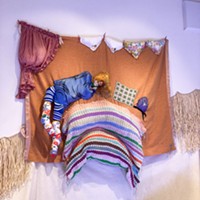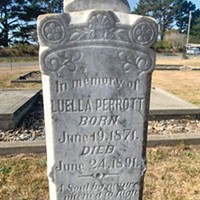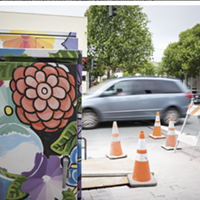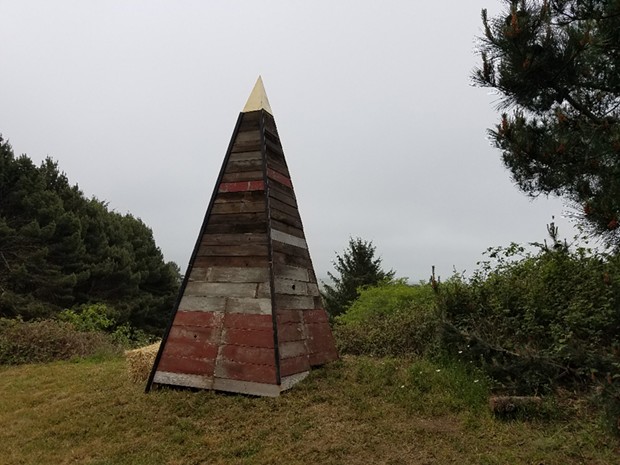[
{
"name": "Top Stories Video Pair",
"insertPoint": "7",
"component": "17087298",
"parentWrapperClass": "fdn-ads-inline-content-block",
"requiredCountToDisplay": "1"
}
]
Outer Roominations, Humboldt's first outdoor, time- and site-sensitive art festival, took place on a Memorial Day that started out cool and shadowless. By midmorning, Table Bluff remained overcast in shades of gray and green, foliage draped in dewdrops. On a hillside meadow, people who'd made the drive wandered in pairs and small groups. Apart from the breeze and the ocean, the loudest sound in earshot was the piccolo rasp of hummingbirds.
Many of the art installations stayed with me, like Dorian Daneau's placement of his creepy, wormlike little tree trolls among alder branches; Bernadette Vielbig's drawings in the landscape, which transformed a green clearing into a rowboat on a rippling pond. Laura Corsiglia's paintings on vellum appeared ghostly in the dim glade where they were suspended, translucent and covered with delicate crinkles, with a stream trickling past and an old concrete trough across it like a makeshift bridge, relic of the land's earlier agricultural history. Nancy Tobin embellished a stand of trees with luau fringe and slung a fabric collage so it could float a canopy on the breeze, liberated from a frame.
Participation actualized artworks to varying degrees. Mango Krueger's stenciled banner announced the availability of "answers from the universe," directing viewers to "close ur eyes / ask a ? ? ? / pull cards / keep ur favs." A mirror sphere positioned by Blake Reagan presented a fish-eye lens distortion of the surrounding landscape, with the viewer at center. At the edge of Table Bluff, gilt-edged "Cloud Viewing Pyramids" made by Reagan with support from Andrew Goff became pin-drop points to gauge the vastness of the cloudy sky.
Some lingering sights and sounds were more about synergistic moments generated by the event itself. On a cliff overlooking the ocean, a group of Native attendees beat drums and burned sage. A smattering of listeners reposed on hay bales while a back-porch didgeridoo soloist blew intricate, sustained patterns. Resident goats reacted with comic astonishment to the soap bubbles drifting over their pen. Collaborators gathered on all fours around developing cyanotypes, scrambling to complete a composition of collaged objects inside the three-to-five-minute window of this solar-powered photo process.
Flashback to the 1960s, when artists around the world associated with postmodern movements including Fluxus, Gutai, Arte Povera and Neo-Concretism began celebrating blurring boundaries separating art from life. In the early 21st century, the participatory approach to artmaking known as relational art or social praxis built on these foundations, importing internet concepts from the 1990s and early aughts: user-friendliness, interactivity, crowdsourcing and DIY approaches. Plenty of arts festivals since have professed the participatory ideal of "no spectators" but Outer Roominations delivered.
The difference between viewers and artists, process and completed artworks, was sometimes fluid and difficult to discern. The exhibition opened Friday but the process of creation was still underway Saturday morning. Anyone walking the forest paths might find an artist toting a floaty armload of tulle, pruning branches or hammering rebar to shore up a section of trail. Festival organizers' cheerful hospitality extended to impromptu shuttle service on a riding lawnmower.
When Goff, a Lost Coast Outpost journalist who hosted and helped organize the festival, named Burning Man as an influence, it made sense. "I think all of us have been to Burning Man in some capacity, so there's a little bit of that DNA in there," he said. "We were just trying to find something to match the spirit of this land."
For one week each year, Burning Man assembles a temporary nomadic community of more than 70,000 people in Nevada's Black Rock Desert. Since the inaugural event in 1986 people have come together annually on the playa to create experimental art installations — including, famously, large scale structures ritually burned to the ground. As a professedly radical experiment in short-term communal living, it has also been a lab where the right to individual self-expression is balanced with responsibility to the community. Co-founder Larry Harvey wrote Burning Man's 10 principles in 2004: radical inclusion, gifting, decommodification, radical self-reliance, radical self-expression, communal effort, civic responsibility, leaving no trace, participation and immediacy.
No Spectators, the title of a 2018 exhibit on the art of Burning Man organized by the Renwick Gallery of the Smithsonian American Art Museum, alludes to radical participation and radical inclusivity. In the words of curator Nora Atkinson, "You are encouraged to fully participate. It's all about being there, being fully present and not just observing ... meaning that there are no outsiders. Everyone is part of the experience."
Goff explained that he and his fellow organizers, artist Blake Reagan and dancer, choreographer and studio owner (as well as Eureka City Council member) Leslie Castellano of Synapsis, planned the event more than a year in advance, "not knowing where the world would be with COVID-19." The organizers accepted a degree of risk in part because "we were going to have it outdoors and have people be spaced out." As they prepared, Goff said, "We felt pretty confident that we would be able to create an experience that would be both safe and magical."
"This property is something that my grandparents bought around the time I was born," he continued. "When my grandmother died in 2013, nobody else in the family really had any interest in living way out here. I was happy to take that on because it's a beautiful piece of land. And that section down the hill, where the trails are, has been overgrown my entire life.
"Three years ago, I got an itch to go explore the lay of the land," says Goff, who made trails on the property. "And especially in this last year, I kind of kicked it into overdrive and said, 'Well, I got nothing to do, so let's make something weird ... Leslie (Castellano) had been out here, and we had walked the trails. We had a few conversations that gave us a rough outline of something we could do. She was really encouraging and helpful in saying that this odd thing that I had been half pondering in my brain was, in fact, possible."
Goff says he wanted to keep the landscape a little "feral," noting, "We didn't need a lot of infrastructure; the land is interesting already. I thought, 'Let's see what shape those spaces naturally take.' It was exciting ... I didn't have a roadmap. I did a lot of thinking down there. How can we renegotiate our relationship to land?
Asked about potential for future renewals, Goff was sanguine. "I'm more stoked then I probably thought I would be. Everyone has been excited about the potential. I was looking around and I was pleased with what we had made, but at the same time, I was like, 'Man, there should be three times as much art here. We need more.'"
Gabrielle Gopinath (she/her) is an art writer, critic and curator based in Arcata. Follow her on Instagram at @gabriellegopinath.
Speaking of...
-

Nancy Tobin's CRy-Baby Installation at CR
Feb 22, 2024 -

Table Bluff Cemetery
May 11, 2023 -

UPDATE: Caltrans: Copyright Contract Grants Rights to Artists
Oct 5, 2020 - More »
more from the author
-
Nancy Tobin's CRy-Baby Installation at CR
- Feb 22, 2024
- More »

































